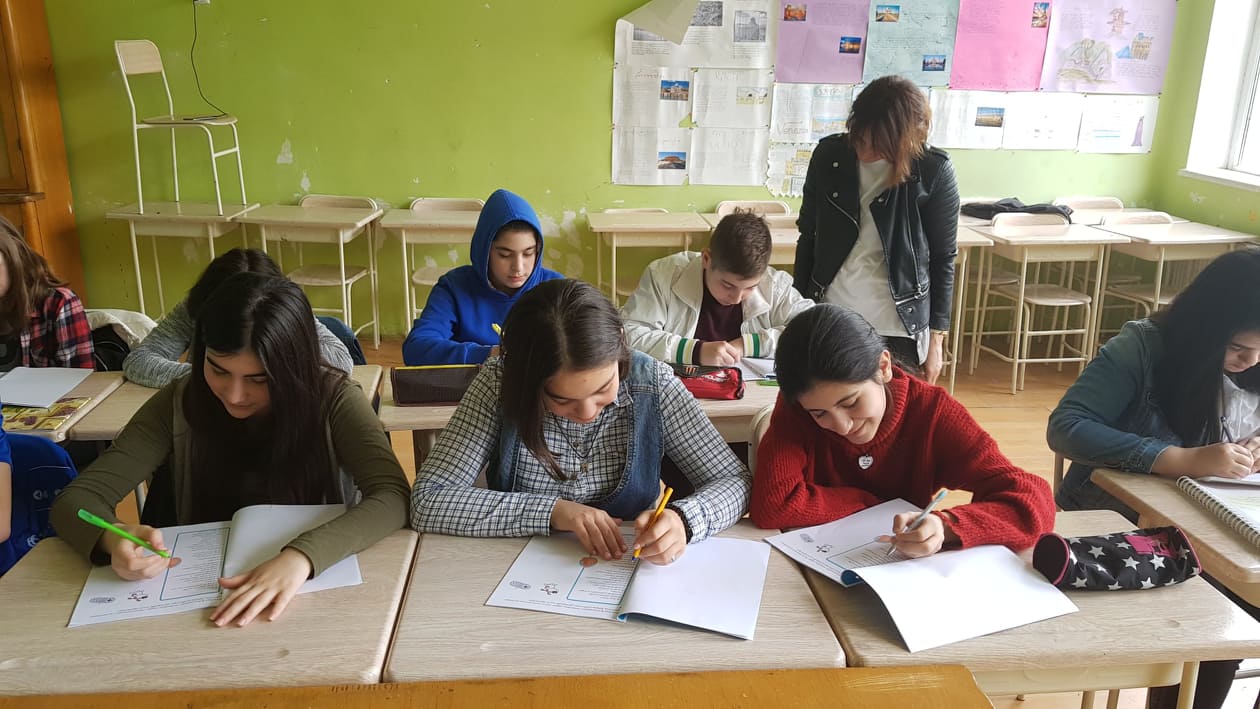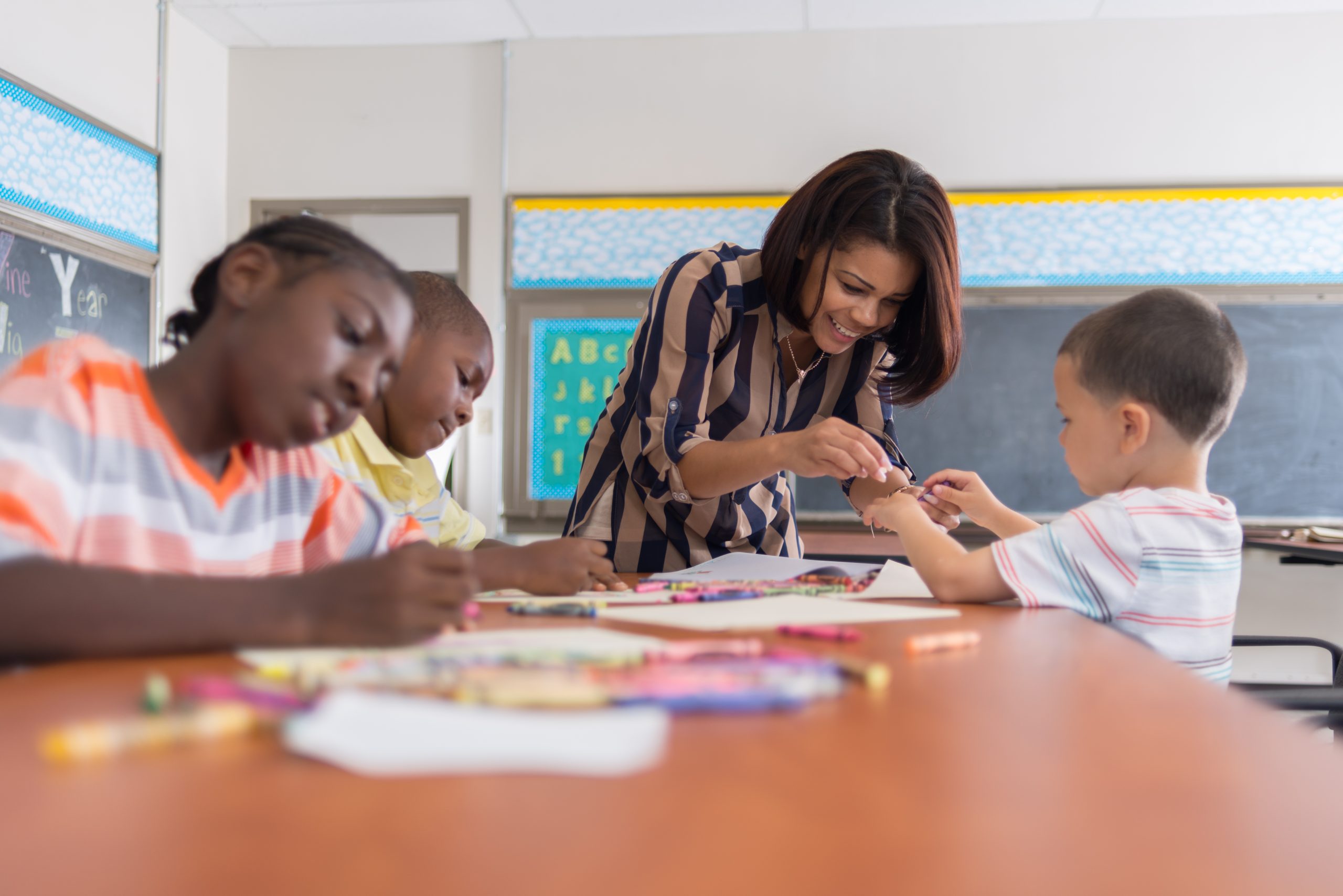
Apply for a Peer Education Grant
OAR has helped educate more than 194,000 children through the Peer Education program since 2012. With the second…
Learn about autism and how you can better support autistic students in the classroom. The following five sections were developed to help teachers better meet the needs of their autistic students. Jump to a section:
For more educator resources, check out our Educator Resources and Professional Development Curriculum.
Autism is a neurological condition typically diagnosed by the age of three. The traits of autism involve multiple major areas of development and impact the way a person:
One of the hallmarks of autism is that the characteristics vary significantly among different autistic children and adults. No two autistic people are the same. In addition, different autistic individuals will need support to greater or lesser degrees across a wide range of contexts. Autism is found in all cultures, genders, and socio-economic groups.
The short answer is that no one knows for sure. In the past 30 years, the prevalence rate of autism has increased dramatically. Recent estimates indicate that autism spectrum disorders occur in 1 out of every 36 children born (CDC, 2023). Autism impacts people across all races and socioeconomic groups, and occurs four times more in boys than in girls.
Some epidemiologists point to a broader definition of autism and an increasing awareness among medical professionals as the key contributing factors to the increase. As more research is funded and completed, this question may soon be answered.
Asperger Syndrome (AS), also known as Asperger’s Syndrome, is a diagnostic term used by professionals between 1994 and 2013. Asperger Syndrome was one of five distinct developmental disorders on the autism spectrum during that time. Some people with Asperger Syndrome choose to continue identifying themselves as persons with AS, or “aspies.”
Based on the DSM-IV, the main differences between Asperger Syndrome and classic autism exist in the language and cognitive areas. Children with Asperger Syndrome do not have delayed language development and display average to above-average intelligence.
Although the characteristics of Asperger Syndrome will vary somewhat from person to person, common qualities include:
In 2013, the American Psychiatric Association released the Diagnostic Manual of Mental Disorders, 5th Edition (DSM-5). Since then, “Asperger Syndrome” has been a discontinued term that is now captured under the broader term, Autism Spectrum Disorder (ASD).
To learn more about how to support students with Asperger Syndrome or Level 1 ASD, check out OAR’s Life Journey through Autism: An Educator’s Guide to ASD (Level 1 Supports).
DSM-IV
In the American Psychiatric Association’s Diagnostic Manual of Mental Disorders, 4th Edition (DSM-IV), autism spectrum disorders were categorized by separate disorders, including:
Traits were organized into three core domains:
DSM-5
In 2013, the APA combined the four diagnoses under the broad term Autism Spectrum Disorder (ASD). Under the DSM-5, people diagnosed with autism are now evaluated based on their traits and the severity in which they exhibit them under two domains:
Traits in both domains must be present in order for people to receive the autism diagnosis. Those who have difficulty communicating or interacting socially but do not exhibit RRBs are diagnosed with social communication disorder, not autism.
Autistic people vary significantly from one another. Their levels of independence and need for support can be further clarified with a diagnosis of Autism Spectrum Disorder – Level 1, Level 2, or Level 3:
Level 1 – Requiring support
Level 2 – Requiring substantial support
Level 3 – Requiring very substantial support
Overall, the changes from DSM-IV to DSM-5 are aimed to better inform clinicians to consistently and more accurately diagnose their patients. In theory, the specified “levels” allow practitioners to have some sense of the amount of supports needed.

Your classroom is already a diverse place. With the rising inclusion of autistic students in general education settings, the challenges associated with managing a classroom will grow. This section outlines a simple and highly flexible six-step plan you and your teaching team can use to prepare for the inclusion of an autistic child in your classroom.
Note: The steps outlined below are summarized steps from OAR’s Life Journey through Autism: An Educator’s Guide to Autism. To read the most complete version, please download or order a free copy of the guidebook.
You must have a working understanding of autism and what that means for your students. Sometimes autistic children may behave in inappropriate or disruptive ways, but their behaviors are more related to their autism than they are deliberate disrespectful acts. Learning about autism and about how it specifically affects your student is the first step to success.
Your education about autism will evolve as your relationship with your student and their family develops; your knowledge about autism and skills in dealing with its impact on the classroom will also continue to grow. Maintaining an open attitude to learning and working closely with the parents and school team will help you (and your student) succeed in the long term.
Parents are your first and best source of information about their child. Step two is all about establishing a working partnership with the families of the students you serve. Not only will you meet before the school year begins, but it is critical to establish methods and patterns of communication for which there is mutual agreement.
Building trust with parents is essential. Communication with families about the progress of the student should be ongoing. While the information you exchange may often focus on current classroom challenges, strategies employed, and ideas for alternative solutions, do not forget to include positive feedback about accomplishments and milestones reached.
There are ways you can accommodate some of the needs of autistic students in your classroom that will enhance their opportunity to learn without sacrificing your plans for rest of the class. Of course, there are practical limitations on how much you can modify the physical characteristics of your classroom, but even a few modifications to support an autistic student can have remarkable results for everyone.
Our Life Journey through Autism: An Educator’s Guide to Autism provides a visual representation of the “ideal” classroom for a child with autism on page 39.
You must make every effort to promote acceptance of an autistic student as a full member and integral part of the class, even if that student only attends class for a few hours each week. As a teacher, you must create a social environment that encourages positive interactions between the autistic student and their typically developing peers throughout the day. Autistic children, by definition, have difficulties with social skill development and understanding language and social cues. With appropriate assistance, however, autistic children can engage with peers and establish mutually enjoyable and lasting interpersonal relationships.
Research shows that neurotypical children have more positive attitudes, increased understanding, and greater acceptance of their autistic peers when provided with clear, accurate, and straightforward information about autism. Assuming there are no restrictions on disclosing that your student has autism, educating your class about autism and how it can affect their classmate can be an effective way to increase positive, social interactions between the autistic student and their classroom peers.
Remember that many social interactions occur in settings outside the classroom. Without prior planning and extra help, autistic students may end up isolated during these unstructured times. You may want to create a “circle of friends,” or a rotating group of responsible peer buddies for the autistic student; they will not abandon them, serve as a model of appropriate social behavior, and protect against teasing or bullying. This strategy should also be considered for use outside of school.
Since your autistic student has special needs beyond academics, their educational plan is defined by an Individualized Education Program (IEP). The IEP is a blueprint for everything that will happen to a child in the next school year. As the principal observer and teacher of the child, you play a key role in the development, implementation, and evaluation of a student’s IEP. You will be responsible for reporting back to the IEP team on the student’s progress toward meeting specific academic, social, and behavioral goals and objectives in the IEP. You will also be asked for input about developing new goals for the student in subsequent IEP meetings.
IEPs are created by a multidisciplinary team of education professionals, along with the child’s parents, and are tailored to the needs of each individual student. Special and general education teachers, speech and language therapists, occupational therapists, school psychologists, and families form the IEP team and meet regularly to discuss student progress toward IEP goals.
Before the IEP team meets, an assessment team gathers information about the student through a formal evaluation. One person on the evaluation team coordinates all the information, and the team meets to make recommendations. The IEP team then meets to write the IEP based on the evaluation and suggestions from team members.
IEPs always include annual goals, short-term objectives, special education services that the student requires, and a yearly evaluation to see if the goals were met. Annual goals must explain measurable behaviors so that it is clear what progress should have been made by the end of the year. The short-term objectives should contain incremental and sequential steps toward meeting each annual goal.
For tips on how to write objectives and develop measurable IEP goals for students with autism, please see Life Journey through Autism: An Educator’s Guide to Autism. You can also read more about Individualized Education Programs (IEPs) here.
For autistic students, problem behaviors may be triggered for a variety of reasons. Such behaviors may include meltdowns, running about the room, loud vocalizations, self-injurious activities, or other disruptive or distracting behaviors. Because autistic children often have difficulties communicating in socially acceptable ways, they may act out when they are confused or fearful about something.
Your first challenge is to decipher the cause, or function, of a particular behavior. Look for patterns in these behaviors such as when they do, or do not, consistently occur. Communicating with families and other team members, and observing the behavior in the context in which it occurs, will be an essential part of learning the function of a specific behavior.
It’s important to use consistent, positive behavioral reinforcement techniques to promote pro-social behaviors for autistic children. This process involves providing reasonable alternatives to undesirable behaviors. The student’s IEP should contain concrete and explicit behavioral goals, as well as a wide range of methods for promoting success achieving them. The student’s parents and IEP team may be able to suggest visual recognition techniques and incentive systems that you can use to reinforce positive behaviors.
Teachers may choose to ignore other negative behaviors or give predetermined consequences. The key is to be consistent with how you react to the behaviors over time, and to use as many positive strategies as possible to promote more desirable behaviors.
As you follow these steps and learn more about autistic children, you will become a mentor to other educators when they face similar challenges for the first time. Your curiosity will fuel your education about autism, and your communication skills will help you create a meaningful alliance with parents. Most of all, you will be able to effectively collaborate with a team that will support an autistic child throughout the course of the school year. Your patience, kindness, and professionalism will make a difference in the lives of all your students.
Having a child with Asperger Syndrome in your class will have a different impact on your classroom environment than having a child with classic autism. But as is the case with all individuals on the autism spectrum, each individual with Asperger Syndrome is different and will present their own unique challenges. This information was written with students with Asperger Syndrome in mind. To date, some individuals with autism choose to refer to themselves as having Asperger Syndrome rather than Level 1 ASD based on the DSM-5.
Following the information below will help prepare you to support a child with Asperger Syndrome in your classroom and foster an inclusive learning environment. The seven steps are simple and highly flexible — think of them as continuing and often concurrent actions.
Note: The steps outlined below are summarized from OAR’s Life Journey through Autism: An Educator’s Guide to ASD (Level 1 Supports). This resource is a revision and update of the third guidebook in OAR’s Life Journey Through Autism series, An Educator’s Guide to Asperger Syndrome. These updates are partially in response to the elimination of “Asperger Syndrome” from the American Psychiatric Association’s Diagnostic Manual of Mental Disorders, 5th Edition (DSM-V) which was released in 2013. The previous version of this guidebook has been retired from OAR’s series.
Children with Asperger Syndrome often display considerable academic strengths. However, these students often require different teaching strategies in order to discover and capitalize on those strengths. Within the school environment, students with Asperger Syndrome also face many obstacles to relationship building and interacting socially with their peers.
The first challenge is to recognize that Asperger Syndrome presents serious challenges for both the student and you. It can be very deceptive, almost hidden to the untrained eye at first. Children with Asperger Syndrome can, at times, look and act much like their typically developing peers. Further, these children tend to perform as well or better academically than their classmates, which has the potential to mask the effects of the disorder.
Asperger Syndrome is a neurological disorder; individuals with the disorder often have difficulty controlling certain behaviors. Most often these behaviors are a function of Asperger Syndrome and not the result of an individual’s willful disobedience or defiance.
Learning about Asperger Syndrome and how it specifically affects your student will help you effectively manage these behaviors. Here are some helpful hints for teachers:
The parents of your student with Asperger Syndrome are your first and best source of information about their child; they can provide you with information about their child’s behavior and daily activities. Ideally, this partnership will begin with meetings before the school year. After that, it is critical to establish mutually agreed-upon modes and patterns of communication with the family throughout the school year. You can use this sample document to maintain communications with parents.
Having learned about the individual sensitivities and characteristics of your student with Asperger Syndrome, you now have the information you need to organize your classroom appropriately. You can manipulate the physical aspects of your classroom, making it more comfortable for children with Asperger Syndrome without sacrificing your plans for the entire class.
Our Life Journey through Autism: An Educator’s Guide to ASD (Level 1 Supports) resource contains information about specific approaches for structuring the academic and physical environment to address your students’ needs.
Children with Asperger Syndrome have social deficits that make it difficult for them to establish friendships. However, with appropriate assistance, they can engage with peers and establish mutually enjoyable and lasting relationships.
The characteristics of Asperger Syndrome can cause peers to perceive a child with the disorder as “strange” or “different.” Children with Asperger Syndrome are more likely than their typically developing classmates to be the victims of teasing and bullying, and often cannot discriminate between playful versus mean-spirited interactions. Teachers and school staff must be aware that students with Asperger Syndrome are potentially prime targets, and they must watch for signs.
Research shows that typically developing peers have more positive attitudes, increased understanding, and greater acceptance of children with Asperger Syndrome when provided with clear, accurate, and straightforward information about the disorder. Thus, educating students about the common traits and behaviors of children with Asperger Syndrome can lead to more positive social interactions between your student and his or her peers.
Many social interactions occur during unstructured times in settings outside the classroom, where students with Asperger Syndrome may end up being isolated. You may want to create a “circle of friends,” or a rotating group of responsible peer buddies for the student with Asperger Syndrome; they will not abandon them, serve as a model of appropriate social behavior, and protect against teasing or bullying. This strategy should also be considered for use outside of school.
School is a stressful environment. Common academic and social situations may create extreme stress for students with Asperger Syndrome. These stressors may include difficulty predicting events because of changing schedules, tuning into teachers’ directions and understanding them, interacting with peers, anticipating change, and structural items such as classroom lighting, sounds, noises, odors, etc.
Meltdowns typically occur in three stages that can be of variable length. These stages and their associated interventions are described more fully in the Educator’s Guide to Asperger Syndrome. Students with Asperger Syndrome rarely indicate (verbally) that they are under stress. While they may not always know when they are near a stage of crisis, most meltdowns do not occur without warning. There is a pattern of behavior, which is sometimes subtle, that suggests an imminent, behavioral outburst. Prevention through the use of appropriate academic, environmental, social, and sensory supports, as well as modification to environment and expectations, are the most effective methods.
Read about Individualized Education Programs (IEPs) here.
Students’ lives are full of transitions, from elementary school and cubbies to middle school and lockers. While these and so many more transitions occur throughout their lives, perhaps one of the most significant transitions is the transition from secondary school to adult life. Planning for the transition of students with Asperger Syndrome out of secondary school into adulthood is an ongoing process outlined by the IDEA, and is the focus of the last step in the seven-step plan.
According to the 2004 revision of IDEA, transitional planning must begin by the time the student is 16, or younger if determined by state law or the IEP team. Our Life Journey through Autism: An Educator’s Guide to ASD (Level 1 Supports) resource contains information about the various skill domains that should be focused on during the transition process.
There are three critical factors in the transition process that should always remain at the center of the team’s efforts: (a) planning for this transition as soon as the student enters school (i.e., as early as possible); (b) individualizing all transition planning to the student; and (c) and involving the student in as much of his or her transition planning as possible. With that in mind, it is important to update the plan to ensure that it is responsive to the student’s current needs and interests.
The Individualized Education Program (IEP) is a blueprint for everything that will happen to a child in the next school year. The planning process involves parents, teachers, and other individuals working with the student who has an autism spectrum disorder. In addition to outlining academic and behavioral goals, the IEP includes interventions, modifications, supports, and hands-on learning opportunities designed to aid autistic students from when they first enter school to the transition to adulthood.
Federal law entitles all students with disabilities to a Free and Appropriate Public Education (FAPE). Federal law also states that students with disabilities should be placed in the Least Restrictive Environment (LRE), where they can make progress toward achieving their goals. Finally, federal law requires that those goals be developed and measured within the framework of an Individualized Education Program (IEP). Autistic students have special needs beyond academics that fall under this law.
IEPs are created by a multidisciplinary team of education professionals, along with the child’s parents, and are tailored to the needs of the individual student. Special and general education teachers, speech and language therapists, occupational therapists, school psychologists, and families form the IEP team and meet regularly to discuss student progress on IEP goals.
Before the IEP team meets, an assessment team gathers information about the student through a formal evaluation. A school psychologist, social worker, classroom teacher, and/or speech pathologist are examples of professionals who may conduct educational assessments. A neurologist may conduct a medical evaluation, and an audiologist may complete hearing tests. The classroom teacher also gives input about the student’s academic progress and classroom behavior, and parents give input to each specialist throughout the process. One person on the evaluation team consolidates all the information, the team meets to make recommendations, then the IEP is written based on the evaluation and suggestions from team members.
IEPs always include annual goals, short-term objectives, special education services that the student requires, and a yearly evaluation to see if the goals were met. Annual goals must explain measurable behaviors so that it is clear what progress should have been made by the end of the year. The short-term objectives should contain incremental and sequential steps toward meeting each annual goal.
For tips on writing objectives and developing measurable IEP goals for students with autism, please see Life Journey through Autism – An Educator’s Guide to Autism.
As the teacher and principal observer, you play a key role in the development, implementation, and evaluation of a student’s IEP. You will be responsible for reporting on the student’s progress toward meeting specific academic, social, behavioral goals and objectives that are outlined in the IEP. You will also be asked for input about developing new goals for the student in subsequent IEP meetings.
The beginning of a new school year is a demanding time for teachers. The transition can be especially challenging when working with autistic students. While change is difficult for these students, keep in mind these tips to make the transition back to school a success.
Apply for a Peer Education Grant
OAR has helped educate more than 194,000 children through the Peer Education program since 2012. With the second…
Celebrate Autism All Year with OAR
While Autism Acceptance Month has come and gone, we know many of you wish to remain active, do more for the cause, or…
Press Release: OAR Awards Spring 2024 Peer Education Grants
Arlington, VA, April 5, 2024 – The Organization for Autism Research (OAR) is excited to announce the recipients of its spring 2024 Peer…



